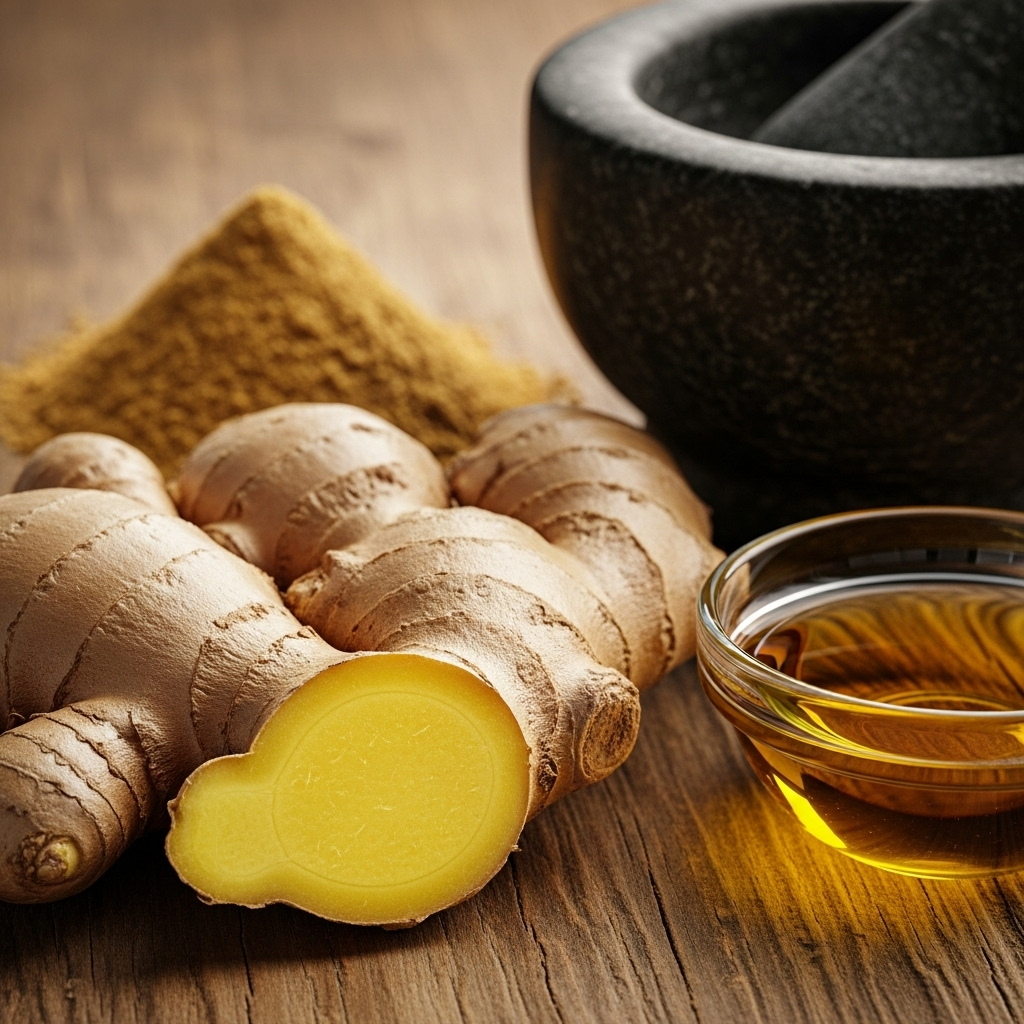In my journey exploring metabolic health optimization, I've found that some of the most potent medicines aren't in pill bottles but in our kitchen cabinets. Today, I want to spotlight an incredible rhizome that has captivated both culinary enthusiasts and medical researchers alike: ginger (Zingiber officinale). This humble root offers remarkable benefits for those managing blood sugar issues or looking to improve their metabolic health.
The Science Behind Ginger's Metabolic Magic
Ginger has been used medicinally for over 5,000 years across Asian cultures, but modern science is finally catching up to what traditional healers have long understood. The bioactive compounds in ginger—primarily gingerols, shogaols, and zingerone—are responsible for its characteristic pungency and, more importantly, its therapeutic effects.
What makes ginger particularly valuable for metabolic health is its dual action as both an anti-inflammatory and antioxidant agent. This matters tremendously because the underlying pathophysiology of type 2 diabetes involves chronic low-grade inflammation and oxidative stress. These two processes create a vicious cycle that promotes insulin resistance and beta-cell dysfunction—the hallmarks of type 2 diabetes.
Research has demonstrated that the phenolic compounds in ginger inhibit several inflammatory pathways, including those regulated by NF-κB, a master regulator of inflammation. By dampening these inflammatory signals, ginger helps break the cycle that perpetuates metabolic dysfunction.
In randomized controlled trials, ginger supplementation has shown impressive results:
- Reductions in fasting blood glucose by an average of 10-15% in people with type 2 diabetes
- Decreases in HbA1c, reflecting improved long-term glycemic control
- Enhanced insulin sensitivity
- Lower triglycerides and improved HDL/LDL ratios
- Modest reductions in body weight and waist-to-hip ratio
What's particularly exciting is that these benefits occur without the side effects associated with many pharmaceutical interventions. While medications certainly have their place, incorporating natural compounds like ginger represents the kind of "both/and" approach that often yields the best results in metabolic health optimization.

Practical Implementation: Getting More Ginger into Your Life
The research on ginger is compelling, but how do we translate this knowledge into daily practice? Here are some practical approaches to incorporating ginger into your metabolic health routine:
Forms of Ginger
- Fresh ginger root: Offers the highest concentrations of active compounds, particularly gingerols
- Dried/powdered ginger: More convenient but contains higher levels of shogaols (formed when gingerols are dried or heated)
- Ginger tea: A pleasant way to consume ginger, especially helpful for digestion
- Supplements: Typically standardized to contain specific amounts of gingerols and shogaols
For metabolic benefits, fresh ginger or high-quality supplements tend to provide the most consistent results. Avoid commercially prepared products like ginger ales or candied ginger, which typically contain minimal actual ginger and high amounts of added sugar—counterproductive for blood glucose management.
Optimal Dosing
Research suggests that meaningful metabolic benefits occur at doses ranging from 1-4 grams of ginger daily. This translates to approximately:
- 1-2 inches of fresh ginger root
- 1/2-2 teaspoons of ground ginger
- 1-2 ginger supplements (typically 500-1000mg each)
I recommend starting at the lower end of this range and gradually increasing as tolerated. Some people may experience mild gastrointestinal discomfort at higher doses, though this is generally temporary as the body adjusts.
Storage Tips
To maintain potency of fresh ginger:
- Store unpeeled ginger in the refrigerator for up to 3 weeks
- For longer storage, freeze whole pieces (no need to peel first)
- Pre-minced ginger can be frozen in ice cube trays with a bit of water or oil for convenient portions
Creative Ways to Incorporate Ginger into Your Metabolic-Friendly Diet
For those managing diabetes or insulin resistance, here are some low-glycemic ways to enjoy ginger's benefits:
-
Morning metabolic booster: Start your day with warm water, fresh lemon juice, a teaspoon of grated ginger, and a pinch of cinnamon. This combination helps prime your metabolism and may improve insulin sensitivity throughout the day.
-
Blood sugar-balancing beverages: Steep fresh ginger in hot water with turmeric and black pepper for a powerful anti-inflammatory elixir. Add a touch of stevia if desired for sweetness without the glucose spike.
-
Protein enhancer: Add freshly grated ginger to marinades for fish, chicken, or tofu. The enzymes in ginger can help tenderize proteins while imparting flavor and health benefits.
-
Vegetable amplifier: Sauté dark leafy greens like kale or spinach with ginger, garlic, and a splash of coconut aminos for a low-carb side dish that supports insulin sensitivity.
-
Dessert alternative: For occasional treats, try making chia pudding with unsweetened almond milk, vanilla, cinnamon, and a small amount of grated ginger. The fiber in chia seeds helps blunt any blood sugar response.

A favorite recipe of mine combines several metabolic powerhouses:
Ginger-Turmeric Smoothie Bowl
- 1/2 cup unsweetened coconut milk
- 1/2 avocado
- 1 tablespoon fresh grated ginger
- 1/2 teaspoon turmeric
- 1 tablespoon chia seeds
- 1/4 cup frozen berries
- Handful of spinach
- Ice to desired consistency
- Optional: scoop of unflavored protein powder
This provides healthy fats, fiber, protein, and minimal impact on blood glucose while delivering a potent dose of anti-inflammatory compounds.

Precautions and Considerations
While ginger is generally safe for most people, there are some important considerations:
- Those on blood thinners should consult their physician, as ginger may have mild anticoagulant effects
- People taking medications for diabetes should monitor blood glucose closely when adding substantial amounts of ginger, as it may enhance the effects of their medications
- Those with gallbladder disease should use ginger with caution
- Pregnant women should stick to culinary amounts rather than supplement forms
As with any intervention for metabolic health, the context matters. Ginger isn't a replacement for foundational approaches like proper sleep, stress management, appropriate physical activity, and a diet focused on whole foods with minimal refined carbohydrates. Rather, it's an adjunctive tool that can enhance these core strategies.
Conclusion: Small Changes, Significant Impact
What I find most compelling about interventions like ginger is their accessibility. While we often focus on cutting-edge pharmaceuticals or complex protocols in managing metabolic disease, sometimes the most powerful interventions are simple, affordable, and hiding in plain sight.
Incorporating ginger into your daily routine represents the kind of small, sustainable change that can contribute to meaningful metabolic improvements over time. The compounding effects of these minor adjustments often yield the most durable results in our health journeys.
Whether you're actively managing diabetes or simply seeking to optimize your metabolic health, consider giving this ancient rhizome a prominent place in your kitchen pharmacy.
References:
-
Li Y, Tran VH, Duke CC, Roufogalis BD. Preventive and Protective Properties of Zingiber officinale (Ginger) in Diabetes Mellitus, Diabetic Complications, and Associated Lipid and Other Metabolic Disorders: A Brief Review. Evidence-Based Complementary and Alternative Medicine. 2012;2012:516870.
-
Zhu J, Chen H, Song Z, Wang X, Sun Z. Effects of Ginger (Zingiber officinale Roscoe) on Type 2 Diabetes Mellitus and Components of the Metabolic Syndrome: A Systematic Review and Meta-Analysis of Randomized Controlled Trials. Evidence-Based Complementary and Alternative Medicine. 2018;2018:5692962.






